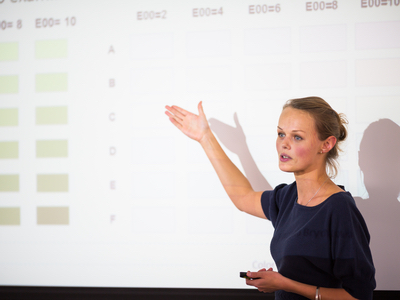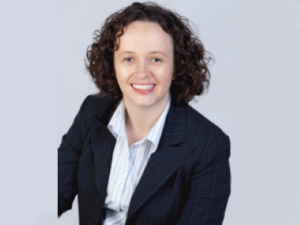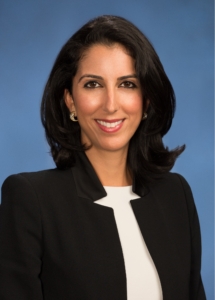Call Nicki Gilmour on +1 646 6882318 or nicki@theglasshammer.com if you want to sign up for individual or group coaching sessions this Fall.
Although WEX’s Noelia Torres began her career as a journalist, then as a public relations practitioner for large consumer brands, her career has been linked to the payments industry for the past 16 years.
She made the move when she realized that although she enjoyed advising clients on strategy, she yearned to see how it all played out and decided to try the client side. She began her finance career at Barclaycard, an independent division of Barclays, in Dublin and then entered what she calls “the exciting world of payments,” where she enjoys contributing to the constant evolution and progress in the payments world.
Over the years she has worked in a wide variety of different markets and geographies, starting in a local market in Spain and then moving on to WEX initially with responsibilities throughout Europe and now she embraces her new challenge of working in global strategy.
Right now Torres is focusing on new ways to innovate and simplify the ways that companies make and receive payments, using a design thinking approach that employs a creative process to solve business problems. . She describes herself as passionate about the methodology because it always begins by looking at people and their unmet needs.. “We have to remember we are always designing for people: You have to understand what each customer wants and needs and how they behave and think when they’re interacting with products or services.”
Teamwork is Goal Number One
When she first entered the corporate world, she expected it to be full of uncertainty and overly competitive, organized in silos where everyone had their own specialization as a sole focus. While her expectation of embracing uncertainty came true, she has since seen that over the years much of the corporate world has evolved, particularly the team orientation. “It’s not about just my sales volume or my meeting,” she says, but doing the best for everyone.
In fact, she considers her ability to build teams as the professional achievement she is most proud of so far — bringing disparate teams together to work toward the same goal. “No matter what department we are in, we want to discover our customers’ problems and solve them,” she points out.
Over the years that has been one of Torres’ biggest learning moments, that the most relevant asset a company has, no matter the size, is their team. She learned that early on when she worked for a Spanish savings bank, Caixa Galicia, with a team composed of only eight people who covered the entire spectrum, from consumer to business to government accounts.
While other, larger companies might have devoted at least 100 people to covering that breadth, her firm wanted to play in the big leagues and strove to provide supreme experience even with a smaller team. “I learned early on and have taken this lesson with me that if you want to achieve a goal, it’s all about the team that surrounds you,” she says.
In fact, that is the first “ingredient” in her professional recipe for success – knowing that working in silos or isolation is ineffective. Secondly she encourages others to listen a lot and then go outside the company to listen more. “Don’t get trapped inside your company; when you go to your customer and ask ‘why,’ you can gain insight that will help you improve.” And finally, she adds “Never give up. I know that we can get better;” as another touchpoint : A leader’s function should be to transform the team to improve.
Opportunities to Learn Are Everywhere
Torres says that both sponsorship and mentorship have been crucial to her success, helping guide her professional career, but also providing direction in her personal domain. “My sponsor in Europe believed in me from the very first day and was key in opening the doors to my most recent move to the United States,” she says.
She names Carina Szpilka, former CEO of ING Direct, as her role model. “She is not only a super charismatic and authentic woman, but she was foundational in revolutionizing banking culture by putting the customer at the heart of business decisions,” Torres notes. But mentorship doesn’t have to just come from the top; she notes that it’s important to remember that you can always learn from everyone you are working with, by finding people on your team who are great leaders or motivators.
WEX, in particular, has been empowering because of the many example of women in key strategic positions throughout the company, which has been inspiring to Torres throughout her career there.
And finally, Torres knows that you can learn from the world around you. She and her husband have a motto that “the world is a book and those who don’t travel read only one page.” They are eager to read the whole book, lived in different countries in Europe and now moving to the United States , learning about people and culture.
Guest contributed by Sarah Brown

Image via Shutterstock
Whether you are a student, a lecturer, a motivational speaker, a budding entrepreneur or a C-suit, when presenting on stage in front of an audience, engaging them and communicating your message can be a daunting task for more reasons than you can imagine. I would be trying to incorporate some of the most important ways to help you in writing a great presentation, become a better presenter and also how to best utilize props.
Although the first few words that come out of your mouth would be about introducing yourself, but you can make it more interesting by sharing your passion about your topic. It is not always about what you say, as a confident presenter with a good sense of humor can be more engaging than someone with equally good content but for instance has fear of public speaking.The first few sentences of your presentation should be able to grab undivided attention from your audience, arouse their curiosity about your topic so that they are completely sold on listening to what is coming next.
An hour’s presentation cannot be written in an hour or even in a day. The time you spend on research and finding the figures, and statistics to support your message is directly proportional to the success of the presentation. Have a rough draft of your presentation speech and the slides ready as early as possible so that you have time to revise it a couple of times. This allows you more time to add, delete, or restructure the content and will also help you convey your message more efficiently. If you write the presentation in the last minute, you might miss on adding important details and also might stray away from the real subject at hand. If you are ready with the final version a few days ahead of time, you can test it out on family and friends for practice. You can also record your presentation and watch it to weed out the obvious errors and flaws. You must carry a small cue card of 3 to 5 things that you feel must be mentioned and should not be left out at any cost and read it just seconds before going on the stage.
Using slides, video or any other media is quite imperative to a presentation. Slides or other media are supposed to carry minimal information and should be used to create relevance or generate specific emotions in the audience. One of the worst things you can do while presenting is reading out text from your slides, word to word. Not only do you look unprofessional and unprepared, you also waste the most resourceful element of presentation, and it drastically makes the presentation boring.
There are a few things that a presenter must keep in mind to avoid distracting the audience from the presentation. First off, one must dress up in a modest manner. Wearing bold colors might take the audience’s attention off the slides. Everyone should be proud of their fashion sense and body but do not forget that the center of attention needs to be the presentation and not the presenter. This might not be an unpopular opinion and might attract some controversy but let me assure you that this comes from some of the most respected male and female public speakers and is not just my personal opinion. Also, you must wear something that you can be comfortable in while looking dressed up. Wearing something you picked up a day before the presentation might not be the best choice as you never know how you can distract the audience while adjusting it. Ladies, if you are not comfortable in wearing high heels, ditch them now.
Watch the tone, speed and volume of your speech. You should not be going too slowly or too fast and also you should not be speaking too loud or too low. Find the right balance. Frequent usage of ‘um’ or ‘like’ should be avoided and replaced with quick pauses instead. Check out this amazing infographic from WalkerStone on Dos and Don’ts of presenting.
It is highly recommended that you test your presentation slides on the hardware available and also have a backup flash drive. At times things do not go as planned, be confident and do not get anxious on stage. If possible, have a contingency plan if your slides don’t work.
Best of luck.
By Nicki Gilmour, Executive Coach and Organizational Psychologist
Recently as part of a paper I was writing, I was examining the elements that increase self-efficacy and improve goal setting for executives.
What makes some people believe that they can do it when others have such doubt? Competence assumed, what are the necessary things to be in place for a professional to achieve their goal? It seems that self-reflection, forethought, intentionality and self-reactiveness are the researched pre-requisites to have to succeed. This makes sense as you need to think about what you want and plan to go for it, with the ability to reflect and act during the course of the task or job (also closely tied to adult learning theories).
So, what stops us from believing that all we have to do is set a goal and put a plan in place to achieve it? In my experience, it seems that it is our inner gremlins that stop us, the nagging self-talk that plays as part of our constant inner theater. We have thoughts and whether they are then implicit (unconscious) or explicit beliefs, they lurk in our minds with emotions and fears attached to them, telling us that we will fail, or look stupid or disappoint someone.
I realized a while ago that I am in the business of killing gremlins because you do not have to be held hostage by the paradigms that have formed or those that have been given to you by your upbringing (family or societal messaging). You literally do not have to believe all that you think to be true. Take the assumptions and put them on the table to understand what is really going on, so you can address what is getting in your way, unpack it emotionally and move on in your life and at work.
Easier said than done? Think about a goal for a second. Mine is running a 5k race and getting fit as I am aware that I want to stay alive for my family and enter middle age in good shape. The problem is I do not really run very often. This behavior is not matching up with the goal and in any normal advice column I would tell the person, in this case myself, to make a plan and stick to it. Sounds simple, right? Wrong, it is not that simple.
Why do rational people who really want to achieve a goal and have a history of knocking the ball out of the park on everything they do, get stuck on small but important goals? Well, like everyone else, I tell myself things to justify what I do or don’t do. Specifically in this case that I do not have time to run more than I do and that working is what I need to do. That is my hidden competing agenda. The gremlin is lurking because it is really my fear of failure that is telling me I do not have time, not anything else. See how this works? To reframe and get on with it, you have to kill the gremlin.
If you would like to have me as your coach (or one of my associates) to kill those gremlins together, then book a free exploratory chat or email me at nicki@theglasshammer.com as we are taking on Fall/ Winter clients -places are limited.
Women excel at the one-on-one relationship-building style of networking, which PwC’s Sue Ann Khoo sees as an advantage as she looks back at her career. “I wish I had believed in myself more at first, but when I realized the advantages to being both a woman and able to understand a different culture, it was a huge boost to my career, given the growing number of clients from Asia, many of whom are women as well,” she says, referencing the often-heard “glass” ceiling and “bamboo” ceiling that women and Asians have to break through to succeed in their career.
She advises women never to say no to opportunities, even if they are outside your comfort zone, because that is how you grow. “You have to be brave to ask for what you want because what’s the worst that could happen?” she asks.
A Cross-Cultural Career
A Malaysian native, Khoo completed her university studies in Australia, then returned to Malaysia where she started her career with PwC. After four years she moved back to Australia and has been there 11 years.
In addition to providing tax advice to foreign companies investing in Australia and Australian companies investing overseas, she leads the Southeast Asian desk in Australia.
“Since Australia, a transparent market, is able to produce attractive yields in the current environment, it’s exciting to help new and existing clients invest in areas such as property, healthcare, agriculture, infrastructure and more,” she says. In return, there are significant opportunities for Australian businesses to invest in Asia with the growing middle class population, in sectors such as education, financial services, healthcare and infrastructure.
In her role as the Southeast Asian desk leader, she regularly engages with Australia and South East Asia government including Ministers and Ambassadors and CEOs of private sectors to drive engagement between Australia and South East Asian businesses.
“There is a need to understand the different ways of working interculturally, so leveraging my knowledge of both Asian and Australian cultures helps bridge the divide,” Khoo notes.
Growing Gender Diversity
While she is proud of becoming a partner in 2016, Khoo considers her most acclaimed professional achievement to be the opportunity she has to mentor women of diverse backgrounds and watch them progress.
“It’s important to surround yourself with mentors who believe in you, even sometimes who believe in you more than you believe in yourself, which gives you the opportunity to succeed,”
she says, a role she is now able to fulfill for the next generation.
Diversity is an important part of PwC Australia’s strategy. With a stated target for the new partners of 40/40/20 – as in, 40 percent male, 40 percent women, and 20 percent either; and 20 percent of partners of diverse cultural background, PwC has attained those numbers for the second year in a row with its current roster of 40 percent female partners and 22 percent who are culturally diverse new partner admissions in 2017. It’s an important initiative to focus on, says Khoo, because she has been surprised at the lack of diverse senior leaders in corporate Australia.
Besides the lack of female role models in Australia, she believes part of the reason is due to the expense of childcare in Australia, one that families in Malaysia often don’t have to shoulder as grandparents are culturally more involved in raising grandchildren , an arrangement that is less prevalent in Australia.
“In Malaysia, many partners and clients in leadership positions were women, and from the start I saw how they were able to balance work and home,” she says, adding that those role models from early in her career helped ignite her determination to become a partner. She acknowledges that her journey to partnership in Australia was not an easy one, as she had to learn the Australia way of working which is different than Asia, spurring the need to learn different styles of working which have helped her cross culturally.
Among the leadership programs that have helped nurture her leadership abilities are the PwC Leadership Talent Pool, designed to offer professional development for directors on the partnership track, and Asian leadership programs such as Asialink Leaders Program and Australia-ASEAN Emerging Leaders Program (A2ELP). She also actively participates in both internal and external diversity events, including serving as a panel speaker for the launch of “Leading for Change, a blueprint for cultural diversity and inclusive leadership in 2016, Australia’s Human Rights Commission initiative.
In her free time Khoo enjoys yoga, which she says relaxes her and also helps her gain perspective. “Holding an uncomfortable pose in yoga is like enduring challenging situations at work,” she points out. In addition, she loves outdoor recreation in the beautiful environs of Sydney and frequently travels to see her family and friends in Malaysia.
During the month of August, The Glass Hammer will be focusing on Asia, featuring profiles of senior level women who are showing up to challenge the gender gap in Asia with their own journeys to leadership.
Take a look at the following articles that take a wider look at the gender dynamics of business in Asia.
Spotlight on Asia: Gender Diversity is Both Catching Up and Leading
When it comes to women representation in business leadership, Asia is at once behind and ahead. For all the societal factors holding women back, marketplace and cultural dynamics are also pulling women into leadership and the C-Suite.
Update: Spotlight on Asia – China and Singapore: Baby Steps Towards Improving Gender Diversity
The Opportunity is Great but the Journey may be Long
McKinsey’s June 2013 report, Women Matter: An Asia Perspective, noted, “women hold very few of the top jobs in Asia. On average, they hold 6% of the seats on corporate boards and 8% of those on executive committees. Moreover, although elements of a gender diversity program are in place in some Asian companies, the issue is not yet high on the strategic agenda of most.”
Update: Spotlight on Asia 2: Japan Continues to Lag in Diversity Rankings
For all of its years as a global economic power, cultural issues and possibly a protracted economic downturn have limited gender diversity in the Japanese workplace. Japan consistently falls near the bottom of the rankings for gender diversity in the workplace. Women hold 2% of board positions (GMI) and 9% of senior management roles (Grant Thorton) according to recent studies.
Guest Contributed By Patricia Harden, President and CEO of Harden Communications Partners
In today’s media-saturated business world, a company’s image is inextricably linked to the reputation of the CEO. Wall Street analysts, marketers and corporate communicators understand the importance of a CEO’s personal brand and how it affects demand for a company’s products or services and its market value.
The “personal brand” of Marc Benioff of Salesforce.com or Tesla’s Elon Musk is an extension of the company. And there are any number of other high-profile male CEOs, who are recognized as industry leaders. How many similarly high-profile women CEOs are there? After HP’s Meg Whitman and Carly Fiorina, who both ran for public office, and a handful of others, it is hard to come up with names. Granted, unfortunately there are simply not as many women as men in the C-suite. However, perhaps the lack of women CEOs with well-defined personal brands is an issue that goes deeper than their respective numbers.
During my 25 years in corporate communications, I have observed many women CEOs that do not eagerly embrace communications tools and strategies to build a powerful personal brand. They are often more reluctant to express their personal values, beliefs and business philosophy than their male counterparts, and frequently, I see successful women leaders who want to stay on “safe” ground, sticking to unassailable fact-based positions.
What’s behind their reticence? I have a theory: On the way up, women CEOs worked incredibly hard just to prove they were as competent (and more so) as men. They had to show they were good team players in order to win the support of colleagues. Advocating a point of view, stretching the boundaries and sharing a bigger “vision” are leadership traits that are subjective, individual and highly visible. Given history, it’s not surprising that women CEOs may err on the side of staying low profile for fear of being criticized as “self-promotional” or grandstanding.
For example, we see women leaders who are press-shy, avoiding media engagement except in the most controlled situations. They seem reluctant to step outside what they see as the confines of their professional roles. One client refused to discuss her accomplishments in building a major data business from the ground up: “I’ll only talk about our product, not myself.” I call this “The Hillary Problem”: Feeling more secure in the role of competent project manager instead of inspirational, but potentially controversial, leader.
While the term personal brand may sound ego-centric, developing an authentic personal brand can add tremendous value to your organization. As a woman leader, what is your personal brand? I believe it is all about becoming known for what you stand for in addition to what you do in your job. Your brand is the “why” behind decisions, choices and results. Inevitably, the “why” involves some subjectivity – and this is where I see women reluctant to capitalize on the credibility that they have earned as CEOS and leaders. Yet I argue that it is absolutely mission critical: It might well be an essential, if unwritten, part of your job description.
Where to start developing a personal brand and leveraging it for the greater good of your company? By working closely with your in-house communications team and public relations advisors, you can develop a strategic plan that will establish and grow your personal brand. It’s not necessary to undergo a personality transplant and become a “celebrity” CEO or another Sheryl Sandberg. Rather, with the right advice and collaboration with professionals, select the issues, forums and communications channels that mesh with your core values and support your organization’s agenda.
“Leaning in” to build and maintain your personal CEO brand isn’t about self-promotion: it’s about advancing your own agenda and that of your company—to step out of your personal comfort zone for the greater good.
Patricia (Pat) Harden founded Harden Partners to help companies be heard, known and valued. Pat brings clients the benefits of a lifelong passion for communication and the desire to help organizations take their game to new levels.
Under her leadership, Harden Partners has grown steadily from a one-person consultancy to an award-winning, mid-sized agency, serving the financial, healthcare and professional services sectors.
An avid reader, theater-goer and traveler, Pat serves on the board of Theatre Bay Area and she and her husband enjoy making Pinot Noir from their home-based vineyard.
This is a Guest Contribution. The views and opinions of the Guest Contributor are not necessarily those of theglasshammer.com
By Nicki Gilmour, Executive Coach and Organizational Pyschologist
Let’s be honest. What happens when you are a highly qualified professional but people just find you hard to work with or work for? This can be a real career staller and can create headaches of having to replace staff who leave you as a manager.
Your behaviors define you. How you show up is what people notice much more than your impressive list of qualifications or even your true competence level. There are many forms of behavior that can derail you, as no matter how nice you are it doesn’t matter if you are confusing people with any of the following traits- control freak, a perfectionist or an unclear communicator.
I pick these three as development points since they assume that you mean well and your intent is good, however your impact on the other person leaves them wondering just how to meet your standards and expectations. They may have tried several ways and are at a loss for words.
How do you find out if you are doing this to your team or direct reports? Well, a feedback tool such as a 360 rater survey is always a good way to see how people perceive you against how you see yourself. As a coach, we use these tools, as do many companies to help you get to stuff that a direct question might not work for. But, if you do have good relationships with peers, it cannot hurt to buy them a coffee and ask what they think your strengths and weaknesses are. If this feels too confrontational or you are not ready to hear it in this format, there are alternative ways to ask for feedback. Here are three ideas
1. Do an “after action review” on a project, unpacking what went well and what could have been done differently. This way the topic is the project but with a little deep questioning around how ideally you could have taken up your formal role, you can harvest gems.
2. Ask your colleague what he or she likes about your work style and what they feel they would like to see more of? Be brave and follow up with a last question along the lines of “what would you like to see less of?”
3. Think about how you show up and list any patterns in jobs or projects of how you think you acted or interacted and then talk it over with a coach to see what felt right and what felt a little odd to you. You will know as you build you EQ and SQ muscles around the accuracy of how people perceive you. However, on this note, we all have our baggage which creates lenses and views which can then distort how we do analyze our interactions. This stuff is crucial to unpack with someone who understands developmental coaching psychology as all executive coaches are not created equal on this front and 100% of the time.
When in doubt, put yourself in other people’s shoes and think about how it would feel to be on the receiving end of certain behaviors. We all have different pet peeves and likes and dislikes but this is still a good place to start!
“Know yourself and be assured of your sense of judgement. This will empower confidence in your decisions,” Padideh Raphael says, noting that this theme has resonated with her since childhood as her mom, a psychologist, raised her with an emphasis on trusting her own instincts, enabling confidence in her choices and encouraging decisive action. “This has been instrumental in allowing me to get to where I am today.”
Finding Her Niche
Although she graduated with a degree in neuroscience, when thinking about a career, Raphael realized that while she loved the field, she didn’t want to work in a lab or a hospital. A close friend recommended she think about finance, and after several rounds of interviews with Goldman Sachs, she began her career at the firm in Goldman Sachs Asset Management in institutional marketing.
Although it was a great introduction to Goldman Sachs, Raphael realized her skills might be better utilized in another part of the firm, and she took advantage of a planned move to London to look into other opportunities. After visiting the trading floor, Raphael immediately knew she belonged in the Securities Division. “I knew I would enjoy the fast-paced environment,” she says, and it’s what she’s done for the last 17 years. After serving as co-head of European Equity Derivatives Flow Sales in London, Raphael moved to Hong Kong three years ago to head Asia Pacific Equity-Derivatives Sales.
“It’s been great to see how markets differ across the world as I have worked in different regions throughout my career,” she notes. As she has gotten to know the Asia market, she views the evolving Chinese economy as the most interesting dynamic she expects to see in the coming years, as China begins to accept external investment to meet a tremendous demand.
Helping Other Women Reach Their Potential
Reflecting upon her career, Raphael pinpoints the moment when she realized she had become a role model for others as an achievement of which she is particularly proud. “As a younger professional, my neck was always craned, looking up to the leaders and drivers of our business and those who were experts at their craft,” Raphael says. “At some point I realized I was that person for more junior members of the group, which is a huge responsibility and one I take seriously.”
“I know I have to be thoughtful about the signals I send,” she says, especially in light of her role as one of the first female partners in international equities.
Her advice to women is to be bold and share your point of view at the onset of your career. “Put it all out there on the field every day,” recommends Raphael. “Women tend to wait for validation before sharing their opinion, but they should speak up earlier.”
Raphael is a first generation American, and her Iranian mom raised her without gender-related boundaries, which served as an important foundation throughout her childhood and into adulthood. “I believe there are no inherent barriers to success in this industry, but in some cases I have seen that women are traditionally raised or shaped to abide by societal norms,” she says. “To the extent possible, women should be confident in having a place in the discussion.”
Family First at Work and Home
When Raphael went on maternity leave with her first child in London, the firm provided a childcare facility that was available for back-up but not full-time care. However, Raphael was determined that she didn’t want to leave her daughter at home, and told her manager that if she was to come back, she wanted to bring her daughter to work on a full-time basis.
“Goldman revamped the on-site child care policy, which was not only a huge vote of confidence and logistical support for me personally, but a testament to the organization in that they gave me the flexibility to arrange my childcare in a way that suited my family’s best interests.”
Raphael was thus able to come back from maternity leave best-positioned to strengthen her career, in part due to the wellness policies Goldman Sachs adopted.
“My family and my career are the two elements that are the defining points of my identity,” Raphael says. “My husband’s support has been instrumental in allowing me to pursue my career.” She notes that cultivating this type of partnership with one’s spouse is helpful when balancing both a family and career.
Raphael has recently rediscovered her love of reading, reinvigorating her passion for both neuroscience and history. She also describes herself as “mildly obsessed” with the history of the British monarchy, identifying parallels between societies. “The role of women in British royal society was very prescriptive, but even during that time period, there were ambitious women that did not allow societal norms to impede their success.”
Take a look at these popular articles previously published on theglasshammer.com
Why Leaders Need More than Mirror Reflections
Amidst increasing access to a broader worldview, we are paradoxically retreating into narrowing, amplified, separated tunnels of perspective.
Why You Should Avoid Overwork To Be Effective In Your Job
Recently in Fortune, Besty Myers, founding director of the Center for Women and Business at Bentley University, called the 24/7 workday “the biggest setback for women in corporate America.”
Why Storytelling Is a Leadership Asset That Takes Many Forms
You can call storytelling a fine art, a talent, a method, a skill, the mark of a leader or all of the above. But what proves effective storytelling is a powerful leadership asset?
The Glass Hammer
Executive coaching, leadership development coaching and career navigation coaching for women looking to develop, advance and lead in top roles.







